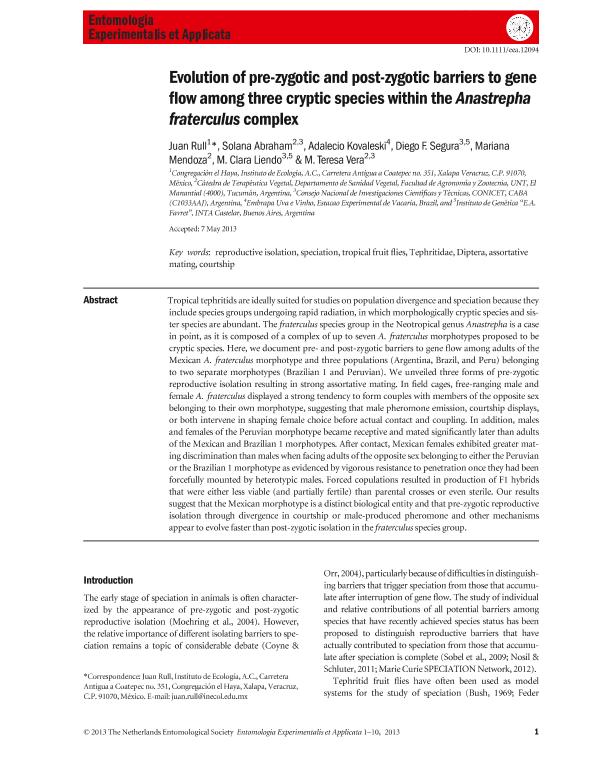Artículo
Evolution of pre-zygotic and post-zygotic barriers to gene flow among three cryptic species within the Anastrepha fraterculus complex
Rull Gabayet, Juan Antonio ; Abraham, Solana
; Abraham, Solana ; Kovaleski, Adalesio; Segura, Diego Fernando
; Kovaleski, Adalesio; Segura, Diego Fernando ; Mendoza, Mariana; Liendo, María Clara
; Mendoza, Mariana; Liendo, María Clara ; Vera, Maria Teresa
; Vera, Maria Teresa
 ; Abraham, Solana
; Abraham, Solana ; Kovaleski, Adalesio; Segura, Diego Fernando
; Kovaleski, Adalesio; Segura, Diego Fernando ; Mendoza, Mariana; Liendo, María Clara
; Mendoza, Mariana; Liendo, María Clara ; Vera, Maria Teresa
; Vera, Maria Teresa
Fecha de publicación:
06/2013
Editorial:
Wiley
Revista:
Entomologia Experimentalis Et Applicata
ISSN:
0013-8703
Idioma:
Inglés
Tipo de recurso:
Artículo publicado
Clasificación temática:
Resumen
Tropical tephritids are ideally suited for studies on population divergence and speciation because they include species groups undergoing rapid radiation, in which morphologically cryptic species and sister species are abundant. The fraterculus species group in the Neotropical genus Anastrepha is a case in point, as it is composed of a complex of up to seven A. fraterculus morphotypes proposed to be cryptic species. Here, we document pre- and post-zygotic barriers to gene flow among adults of the Mexican A. fraterculus morphotype and three populations (Argentina, Brazil, and Peru) belonging to two separate morphotypes (Brazilian 1 and Peruvian). We unveiled three forms of pre-zygotic reproductive isolation resulting in strong assortative mating. In field cages, free-ranging male and female A. fraterculus displayed a strong tendency to form couples with members of the opposite sex belonging to their own morphotype, suggesting that male pheromone emission, courtship displays, or both intervene in shaping female choice before actual contact and coupling. In addition, males and females of the Peruvian morphotype became receptive and mated significantly later than adults of the Mexican and Brazilian 1 morphotypes. After contact, Mexican females exhibited greater mating discrimination than males when facing adults of the opposite sex belonging to either the Peruvian or the Brazilian 1morphotype as evidenced by vigorous resistance to penetration once they had been forcefully mounted by heterotypic males. Forced copulations resulted in production of F1 hybrids that were either less viable (and partially fertile) than parental crosses or even sterile. Our results suggest that the Mexican morphotype is a distinct biological entity and that pre-zygotic reproductive isolation through divergence in courtship or male-produced pheromone and other mechanisms appear to evolve faster than post-zygotic isolation in the fraterculus species group.
Palabras clave:
Reproductive Isolation
,
Speciation
,
Tropical Fruit Flies
,
Tephritidae
Archivos asociados
Licencia
Identificadores
Colecciones
Articulos(CCT - NOA SUR)
Articulos de CTRO.CIENTIFICO TECNOL.CONICET - NOA SUR
Articulos de CTRO.CIENTIFICO TECNOL.CONICET - NOA SUR
Articulos(SEDE CENTRAL)
Articulos de SEDE CENTRAL
Articulos de SEDE CENTRAL
Citación
Rull Gabayet, Juan Antonio; Abraham, Solana; Kovaleski, Adalesio; Segura, Diego Fernando; Mendoza, Mariana; et al.; Evolution of pre-zygotic and post-zygotic barriers to gene flow among three cryptic species within the Anastrepha fraterculus complex; Wiley; Entomologia Experimentalis Et Applicata; 148; 3; 6-2013; 213-222
Compartir
Altmétricas



